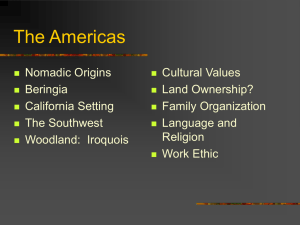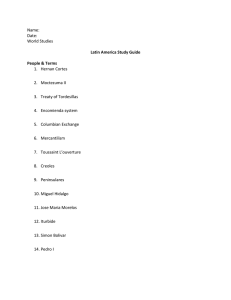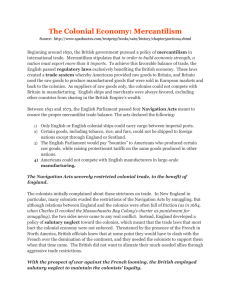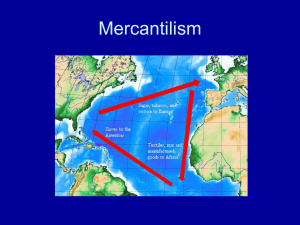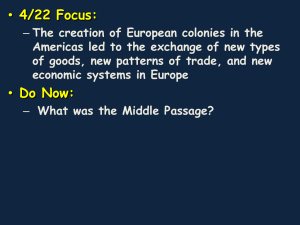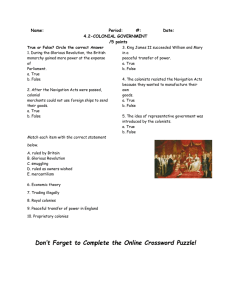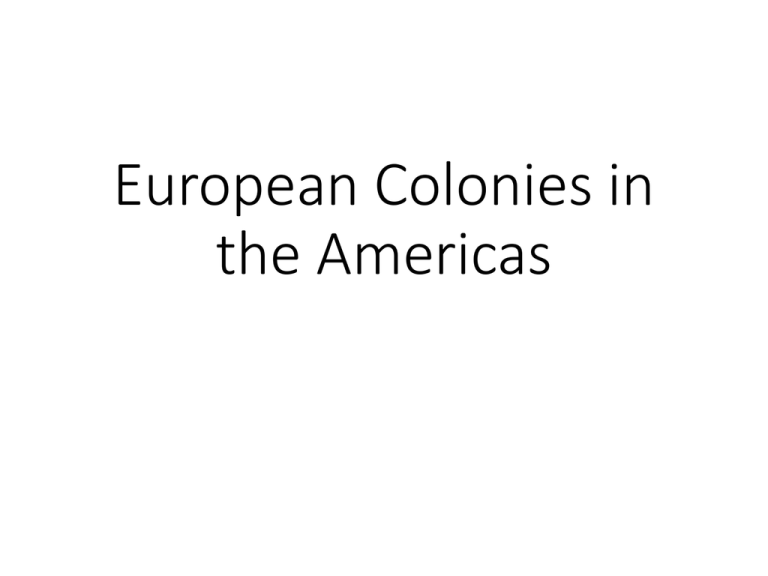
European Colonies in
the Americas
European Colonization
Colonies in order of economic value
1. Areas with silver and gold mines
Central Mexico; Peru and Bolivia
2. Trading posts in Asia
3. Cash crop regions
Spices – islands in Indonesia
Sugar, tobacco, indigo – tropical Americas
4. Slave ports in Africa – labor for cash crops
5. Distant fifth: everything else
Canada, New England, Argentina, No. Mexico, Pacific
Northwest
European Colonization
Example of colonial priorities:
Seven Years’ War (1756-1763)
Britain vs. France; war starts in N. America
English colonists: “French and Indian War”
France lost, must choose which to give up:
Almost all of French Canada
or
tiny little Guadeloupe Island, in Caribbean
Result: France gave up Canada, kept Guadeloupe
Why?
Guadeloupe’s sugar was worth more than all products
from French Canada combined.
European Colonization
Example of colonial priorities
Most valuable real estate in the Western world in the
1700’s?
A: Sugar plantations in St. Domingue (Haiti)
One of the highest per-capita income in the world
Even with slaves included in the calculation!
Industrialization, long-term colonization leads to
reversal:
Haiti now one of the poorest countries
Chapter One:
The Collision of Cultures
© 2011, The
McGraw-Hill
Companies, Inc. All
Rights Reserved.
Spanish America
7
Mercantilism
• Colonial economic system in Americas
• Economic theory/assumptions:
• Wealth is finite – can be moved, but not created
• Bring in more precious metals than you spend
• Manufactured goods more profitable than raw materials
• NOT a free trade capitalist system
•
•
•
•
Merchant class with privileges
Monopolies, exclusive licenses in many sectors
Colonial economy supposed to be a sealed system
Protection against competition
Mercantilism
Mercantilism
• Colonies’ role
• “Primary sector”
• Raw materials – metals, wood, etc.
• Agricultural products
• Fish, fur
• Some labor, some tax revenue
• Most valuable: silver and gold mines
• Second most: cash crop areas, esp. sugar
• Distant third: everything else
• (Minor) market for goods from mother country
Mercantilism
• Home country (“metropole”) role
• Manufactured goods, imports
• Much more valuable than raw materials
• Government, defense, diplomacy
• Source of immigrants
• Promote, defend slave trade
Mercantilism
• Overtly about benefitting home country first
• NOT about econ. development of colonies
• Discourages economic diversity in colonies
• Colonists supposed to benefit indirectly
• Profits largely in European hands
Mercantilism
• Difference between theory and practice
• Hard to stop all smuggling, piracy
• Smugglers pirates
• Large black market
• Some areas w/ little European oversight
• Question of cost/benefit
• Lax enforcement in N. America = “salutary neglect”
• Sometimes self-government by default
• Sense of independence becomes ingrained
• Hard to re-establish control later
Mercantilism
• Many colonies operated at a loss for the gov’t
• Tax revenue often less than gov’t spending
High military costs:
Seven Years’ War (1756-63) cost:
100 years’ worth of colonial taxes
• Gov’t benefits often indirect
• Hard to stop smuggling, piracy
Mercantilism
• Many cols operated at a loss for the imperial gov’t
• Profits largely went to private interests
• British N. Amer. colonists taxed LIGHTLY
• 1763 – 1/26 the level people paid in England
• 1765 – Stamp Act
• Tax on paper in the colonies
• Same tax already established in England
(For the past 150 years)
• Boston Tea Party (1770) a protest against
corporate power in government, NOT against
taxes
“Primary sector”
Most basic, oldest, most fundamental kinds of
production
• Commodities most directly from natural
origin
• Farming, hunting, fishing, whaling
• “Extractive” industries
• Mining, timber, oil drilling
broad arrow mark,
signifying a “King’s Tree”
Historical
marker
(millstone)
Weare, New
Hampshire
Site of Quimby’s Inn, site of 1772
“Pine Tree Riot”

